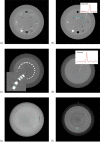A study on image quality provided by a kilovoltage cone-beam computed tomography
- PMID: 23318380
- PMCID: PMC5714052
- DOI: 10.1120/jacmp.v14i1.3888
A study on image quality provided by a kilovoltage cone-beam computed tomography
Abstract
The image-guided radiotherapy technique (IGRT) makes use of imaging devices to verify the positions of the target volume and organs at risk during the treatment sessions. In this work we evaluate the image quality provided by an imaging system based on a kilovoltage cone-beam CT, and explore its ability to perform IGRT and adaptive radiotherapy. We analyze the accuracy of the image slice width, the spatial resolution using the MTF function, the image uniformity, the signal-to-noise ratio, the contrast-to-noise ratio, the low-contrast sensitivity, and the HU linearity with density. The studied parameters are evaluated in an objective and quantitative way, allowing for a direct comparison with other imaging devices. We conclude that the analyzed cone-beam imaging system is adequate to accurately perform IGRT within its clinical use, despite the high level of noise present in a cone beam caused by scatter. We also point out the presence of a bowtie wobble artifact in the reconstructed images. Nevertheless, we conclude that these features do not limit the capability of the system to perform adaptive radiotherapy in most cases.
Figures









References
-
- Herman MG, Balter JM, Jaffray DA, et al. Clinical use of electronic portal imaging: Report of AAPM Radiation Therapy Committee Task Group 58. Med Phys. 2001;28(5):712–37. - PubMed
-
- Ding GX, Duggan DM, Coffey CW, et al. A study on adaptive IMRT treatment planning using kV cone‐beam CT. Radiother Oncol. 2007;85(1):116–25. - PubMed
-
- Nijkamp J, Pos FJ, Nuver TT, et al. Adaptive radiotherapy for prostate cancer using kilovoltage cone‐beam computed tomography: first clinical results. Int J Radiat Oncol Biol Phys. 2008;70(1):75–82. - PubMed
-
- Hatton JA, Greer PB, Tang C, et al. Does the planning dose‐volume histogram represent treatment doses in image‐guided prostate radiation therapy? Assessment with cone‐beam computerised tomography scans. Radiother Oncol. 2011;98(2):162–68. - PubMed
-
- Létourneau D, Wong R, Moseley D, et al. Online planning and delivery technique for radiotherapy of spinal metastases using cone‐beam CT: image quality and system performance. Int J Radiat Oncol Biol Phys. 2007;67(4):1229–37. - PubMed
Publication types
MeSH terms
LinkOut - more resources
Full Text Sources
Other Literature Sources
Miscellaneous

